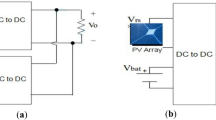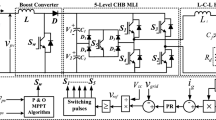Abstract
In this paper, the performance of power electronic converters like non-isolated DC–DC converters and a three-phase PWM controlled rectifier under ideal conditions was performed. Mathematical models for ideal Buck, Boost, Cuk, and SEPIC converters operating in Continuous Conduction Mode (CCM) were derived using volt-sec and amp-sec balance equations. The model provided details about the transient and steady-state behavior of the converters in open-loop configuration. The modeling was performed using MATLAB/Simulink using ‘Commonly Used Blocks’. It was found that the approach shown in this paper worked well on all versions of the software and hence, the dependence on the Sim Power Tool Box is removed. The importance of selecting inductors and capacitors during transients for the chose converters is highlighted. The dynamics are well captured by selecting an appropriate step size for solving the differential equations. It was found that among all the converters, for the given specifications, Boost and Cuk converters reached the steady-state voltage value at 0.01 s (faster than SEPIC).































Similar content being viewed by others
Reference
N.L. Hinov. Mathematical modeling of transformerless DC–DC converters. In: 2018 IEEE XXVII International Scientific Conference Electronics-ET. IEEE; 2018. pp. 1–4.
S. Surya, V, Patil. Cuk converter as an efficient driver for LED, In: 2019 4th International Conference on Electrical, Electronics, Communication, Computer Technologies and Optimization Techniques (ICEECCOT). IEEE; 2019. pp. 49–52.
X.D. Gumera, A. Caberos, S.-C. Huang. Design and implementation of a high efficiency cost effective EV charger using LLC resonant converter. In: 2017 Asian Conference on Energy, Power and Transportation Electrification (ACEPT). IEEE; 2017. pp. 1–6.
M.A.K.A. Biabani. Simulation, mathematical calculation and comparison of power factor and efficiency for forward, fly back and proposed forward-flyback converter. In: 2016 International Conference on Electrical, Electronics, and Optimization Techniques (ICEEOT). IEEE; 2016. pp. 1583–9.
S. Surya, M.N. Arjun. Effect of fast discharge of a battery on its core temperature. In: 2020 International Conference on Futuristic Technologies in Control Systems & Renewable Energy (ICFCR). IEEE; 2020.
S. Surya, R. Srividya. Isolated converters as LED drivers, In: Cognitive Informatics and Soft Computing (accepted).
Surya S, Channegowda J, Naraharisetti K. Generalized circuit averaging technique for two switch DC–DC converters. arXiv preprint. 2020; arXiv:2012.12724.
Surya S, Williamson S. Generalized circuit averaging technique for two-switch PWM DC-DC converters in CCM. Electronics. 2021;10(4):392.
S. Surya. Mathematical modeling of DC–DC converters and Li ion battery using MATLAB/Simulink. In: Electric Vehicles and the Future of Energy Efficient Transportation. IGI Global; 2021. pp. 104–43.
S. Surya, D.B. Singh. Comparative study of P, PI, PD and PID controllers for operation of a pressure regulating valve in a blow-down wind tunnel. In: 2019 IEEE International Conference on Distributed Computing, VLSI, Electrical Circuits and Robotics (DISCOVER), IEEE; 2019. pp. 1–3.
Hart DW. Power electronics. Tata McGraw-Hill Education; 2011.
Erickson RW, Maksimovic D. Fundamentals of power electronics. Springer Science & Business Media; 2007.
Acknowledgements
The authors would like to express sincere thanks to Mr. Vineeth Patil, Dept. of Electrical and Electronics, MIT, Manipal for the overall encouragement.
Author information
Authors and Affiliations
Corresponding author
Additional information
Publisher's Note
Springer Nature remains neutral with regard to jurisdictional claims in published maps and institutional affiliations.
This article is part of the topical collection “Data Science and Communication” guest-edited by Kamesh Namudri, Naveen Chilamkurti, Sushma S J and S. Padmashree.
Rights and permissions
About this article
Cite this article
Surya, S., Arjun, M.N. Mathematical Modeling of Power Electronic Converters. SN COMPUT. SCI. 2, 267 (2021). https://doi.org/10.1007/s42979-021-00637-1
Received:
Accepted:
Published:
DOI: https://doi.org/10.1007/s42979-021-00637-1




